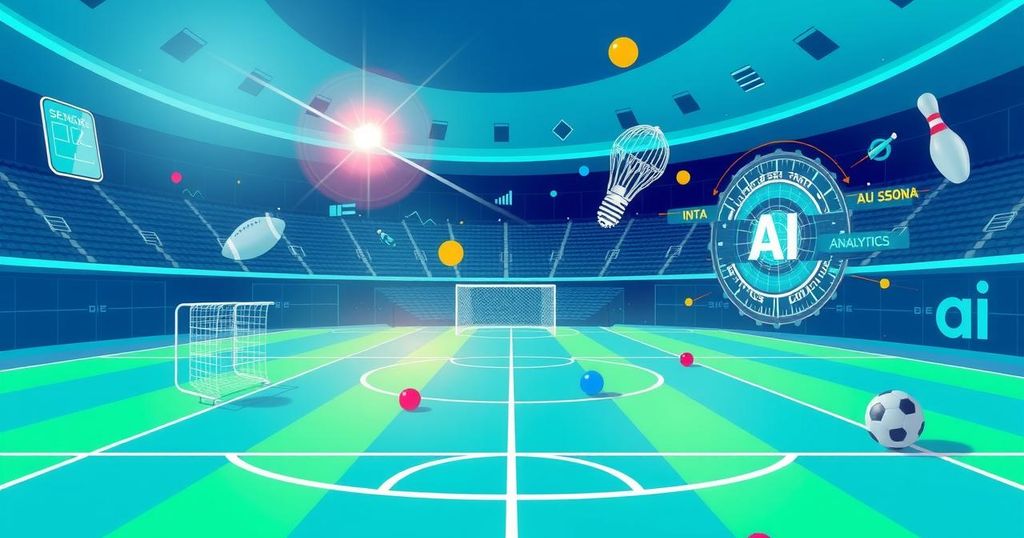AI Takes the Field: How Artificial Intelligence Redefines Sports
Sports in April are thriving, with baseball, NBA playoffs, and the NFL draft headline events. However, the real game-changer is artificial intelligence, infiltrating every aspect of sports—from performance optimization to fan engagement. AI’s influence spans across football, soccer, baseball, bowling, running, and more, making sports smarter, safer, and increasingly interactive. The digital revolution is reshaping the experience for athletes and fans alike.
For sports enthusiasts, April brings a feast of competition. Major League Baseball returns to the diamond, the NBA playoffs are heating up, and the NFL draft is transforming college stars into the next household names. Even the quiet game of bowling has entered the digital age, though it hasn’t yet stolen the spotlight from the NFL. But beyond these highlights, there’s something bigger happening, and it’s all thanks to artificial intelligence, now infiltrating every corner of the sports landscape, from the field to your living room—and yes, even your local bowling alley.
AI’s impact on football seems almost as fundamental as a well-timed defense. In the NFL today, teams strap on AI-powered sensors embedded in helmets and pads, gathering detailed data on player movements and collisions. Machine learning then processes this information, refining training methods, reducing the risk of injuries, and even suggesting plays in response to opponents’ tactics. On the sidelines, AI combs through heaps of game footage to help coaches read rival strategies mid-game. Fans, too, benefit directly—AI overlays give real-time stats and predictions, making watching the game feel less like a spectator sport and more like an interactive experience.
Across the pitch in soccer, teams are embracing AI for everything from scouting fresh talent to sharpening tactical strategies. AI-driven video analysis breaks down matches with astonishing precision, sifting through countless hours of footage to find emerging stars and hidden patterns. Wearables track everything from stamina to positions, and edge computing ensures immediate feedback during games. Remarkably, apps like AiScout allow budding players to upload their training videos for algorithmic evaluation, leveling the playing field for up-and-coming stars. Even on game day, improved officiating, courtesy of AI camera systems, has made offside calls and ball tracking substantially more accurate, cutting down on disputes.
Baseball, a sport steeped in tradition and statistics, has also become a playground for AI developments. Here, teams are turning to data scientists who simulating countless pitcher-batter matchups, using deep learning models to predict outcomes and optimize training plans. AI systems monitor mechanics and workloads, spotting potential injuries before they happen. Meanwhile, automated highlight generators are keeping fans hooked with instant replays and tailored content. Yet, this rapid development comes with questions about data ethics and privacy—issues now as critical as batting averages or earned run averages.
Bowling, too, is not to be left behind in the AI revolution. The sport is quietly being transformed by technology that powers instant scoring and analyzes every throw’s speed, spin, and angle. Tools like Gemini AI provide tailored coaching tips and engage bowlers with dynamic commentary, shifting the bowling alley into a digital innovation hub. Verified competitions and global leaderboards are connecting bowlers everywhere, turning an age-old hobby into a globally recognized sport.
For runners, AI is also making waves. From mobile apps utilizing biomechanics to check a runner’s gait to personalized drills aimed at reducing injuries, the assistance is unprecedented. AI coaching platforms flexibly modify training regimens based on real-time data like fatigue and weather. Wearable tech now works without needing the cloud, offering instant feedback for those jogging through parks or along quiet trails.
In sports like tennis, systems like PlaySight and SmartCourt are on the rise, analyzing every movement and providing players with feedback during matches. AI coaches offer insights on technique and strategy, bringing elite analysis to club players and younger athletes. Furthermore, automated line-calling tech like Hawk-Eye nearly eliminates human errors, while AI-enhanced broadcasts keep fans engaged with real-time stats and predictions.
Lastly, fitness apps and smart mirrors now leverage AI to track workouts. They assess form, count repetitions, and offer immediate corrections, customizing routines based on individual progress. Plus, real-time feedback through edge computing keeps users motivated and connected during workouts, transforming solitary exercises into engaging group experiences online.
In basically all of these sports, AI emerges as the unsung MVP, handling complex data, enhancing performance, preventing injuries, and enriching viewer experience. Whether chasing records, personal milestones, or just some fun at the local bowling alley, the digital age is here and it’s reshaping every aspect of sports, making them smarter, safer, and a heck of a lot more exciting. So when you watch or lace up your sneakers next time, keep in mind: the future of sports isn’t just on the field; it’s also etched into the algorithms quietly working in the background.
AI is completely revolutionizing the landscape of sports. From minimizing injuries in football to enhancing officiating in soccer, the influence is extensive. Baseball is leveraging AI to analyze player performance, while bowling taps into tech for real-time scoring and analysis. Runners and fitness enthusiasts benefit from tailored coaching experiences, thanks to AI innovations. The digital transformation is not just about play; it’s about making the entire experience smarter and more engaging.
Original Source: www.pymnts.com




Post Comment